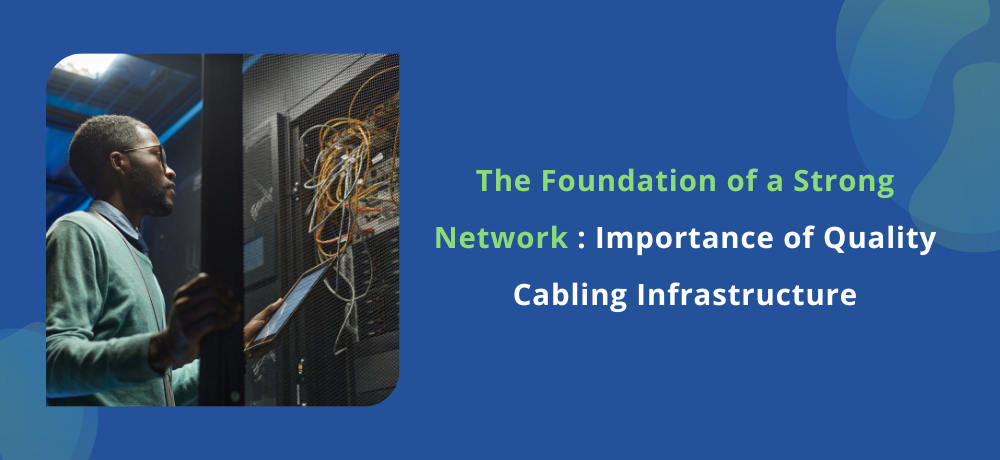The Foundation of a Strong Network: Importance of Quality Cabling Infrastructure

In the age of digital connectivity, where businesses in Toronto, Mississauga, Milton, and the entire Greater Toronto Area (GTA) rely heavily on network communication, the foundation of a strong network lies in its cabling infrastructure. ExcelLinx Communications, a trusted provider of high-quality solutions for Data Centres, Network Infrastructure, Converged Media and Audio Visual, Business Telephony, Security, and nationwide IT project rollouts, understands the pivotal role that cabling infrastructure plays in ensuring seamless operations.
The Backbone of Connectivity
Quality cabling is the backbone of any network. It forms the physical infrastructure through which data flows. The expertise lies in designing and installing cabling solutions that can support high-speed data transmission, ensuring your business never experiences connectivity bottlenecks. It refers to the essential infrastructure and technologies that serve as the foundation for modern communication and information exchange. This backbone consists of a complex network of physical and digital components, including high-speed internet connections, fiber optic cables, data centers, routers, and switches.
This backbone is the backbone of the digital age, enabling people, businesses, and governments to connect, share information, and access services across the globe. It underpins the functionality of the internet, allowing for real-time communication, cloud computing, online commerce, and much more. The reliability, speed, and capacity of this connectivity backbone are critical for the success of numerous industries and the overall functioning of our increasingly interconnected world. It continues to evolve and expand to meet the growing demands of our digitally-driven society, making it an indispensable part of our modern lives.
Minimizing Downtime
Minimizing downtime is a paramount objective for businesses and organizations in today's fast-paced and interconnected world. Downtime refers to periods when critical systems or operations are unavailable due to various factors, such as technical failures, maintenance, or unforeseen disruptions. The impact of downtime can range from lost productivity and revenue to reputational damage and customer dissatisfaction. To address this, businesses employ various strategies to minimize downtime and maintain uninterrupted operations.
One key approach is proactive maintenance and monitoring. Regular inspections and maintenance of equipment, software, and infrastructure can help identify potential issues before they escalate into major problems, reducing the risk of unexpected downtime. Additionally, employing redundant systems and failover mechanisms ensures that if one component fails, another takes over seamlessly, minimizing disruptions. Comprehensive disaster recovery and business continuity plans are also essential, providing clear procedures and resources to recover quickly from unforeseen events, such as natural disasters or cyberattacks. By implementing these strategies, businesses can bolster their resilience and minimize the impact of downtime, ultimately ensuring the continuity of critical operations.
Scalability for Growth
Scalability is a critical consideration for businesses looking to accommodate growth and adapt to changing demands. It refers to the ability of a system, process, or organization to handle an increasing workload or expand its capacity without significant disruptions or the need for a complete overhaul. Scalability is particularly vital in the digital era, where businesses must rapidly respond to market shifts and emerging opportunities.
One common example of scalability is in cloud computing. Cloud services allow businesses to scale their IT infrastructure up or down as needed, paying only for the resources they use. This flexibility empowers organizations to efficiently respond to changes in demand, whether it's accommodating increased website traffic during a marketing campaign or expanding data storage capacity to accommodate growing customer data. By embracing scalable technologies and practices, businesses can position themselves for sustainable growth, cost-effective operations, and improved agility in a competitive landscape.
High-Performance Data Transfer
High-performance data transfer is a critical requirement in today's data-driven world where organizations routinely move vast amounts of information for various purposes. Whether it's transferring large files, conducting real-time data analytics, or replicating data for disaster recovery, the speed and efficiency of data transfer can significantly impact productivity and decision-making.
To achieve high-performance data transfer, organizations often leverage advanced data transfer protocols, high-bandwidth network connections, and optimized data transfer software. Techniques such as data compression, parallel processing, and traffic prioritization can further enhance the speed and reliability of data transfers. Additionally, the use of content delivery networks (CDNs) and edge computing helps reduce latency, ensuring that data reaches its destination swiftly. High-performance data transfer not only improves operational efficiency but also enables businesses to harness the full potential of big data analytics and other data-intensive applications, ultimately leading to better-informed decisions and a competitive edge in the digital landscape.
Cost-Effective Maintenance
Cost-effective maintenance is a key objective for businesses and organizations aiming to keep their operations running smoothly while managing expenditures efficiently. Maintenance encompasses various activities, including equipment upkeep, facility management, and technology support, all of which are essential for preventing downtime and ensuring longevity. To achieve cost-effective maintenance, organizations often adopt a proactive approach that focuses on preventive and predictive maintenance strategies.
Preventive maintenance involves regular inspections and servicing of equipment to address wear and tear before it leads to breakdowns or failures. This approach helps extend the lifespan of assets, reduce unplanned downtime, and lower the overall cost of ownership. Predictive maintenance, on the other hand, leverages data analytics and condition monitoring to predict when maintenance is needed, allowing organizations to schedule repairs or replacements precisely when required, optimizing resource allocation and minimizing costs. By implementing these strategies and embracing modern maintenance technologies, businesses can strike a balance between maintenance expenses and operational efficiency, ultimately contributing to their bottom line.
The importance of a robust cabling infrastructure cannot be overstated. Whether you're in Bolton, Caledon, or elsewhere in the GTA and the Greater Golden Horseshoe area, ExcelLinx Communications is your partner in building and maintaining a strong network foundation. Our team brings together 15+ years of experience in the cabling and wireless marketplace. We are committed to implementing every solution on time and on budget.
Get in touch with us today
To learn more about what we do, please click here. To contact us, please click here or call us at (647) 362-1979.